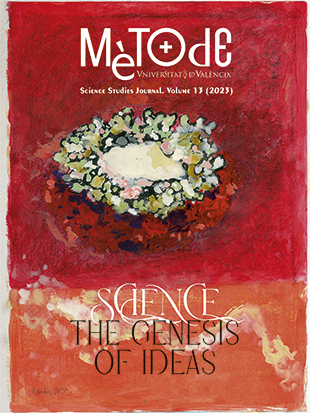És la bellesa un criteri de veritat? Qualitat genètica o criteris estètics, motors de la selecció sexual en animals
DOI:
https://doi.org/10.7203/metode.13.24722Paraules clau:
selecció sexual, bellesa, biologia evolutiva, evolució Resum
Resum
Perceben la bellesa de les flors l’abella o el colibrí que s’hi acosten per a recol·lectar-ne el nèctar? És a dir, poden els animals no humans apreciar-la? Existeix una veritat universal sobre la bellesa? O només és un atribut útil, un indicador d’un tret valuós? Com succeeix amb tants altres fenòmens naturals, no hi ha una resposta simple a aquestes preguntes. En l’article següent analitzem diferents aspectes sobre la selecció natural i la seua relació, o no, amb els criteris estètics i amb l’anomenat principi del hàndicap.
 Descàrregues
Descàrregues
 Referències
Referències
Brown, S. (2022). Naturalizing aesthetics. In A. Chatterjee & E. R. Cardillo (2022), Brain, beauty, & art: Essays bringing neuroaesthetics into focus (pp. 18–21). Oxford University Press. https://doi.org/10.1093/oso/9780197513620.003.0004
Buskes, C. (2006). Evolutionair denken: De invloed van Darwin op ons wereldbeeld. Uitgeverij Nieuwezijds.
Chatterjee, A., & Cardillo, E. R. (2022). Prologue: Where have we been, and where are we now? In A. Chatterjee & E. R. Cardillo, Brain, beauty, & art: Essays bringing neuroaesthetics into focus (pp. XI–XII). Oxford University Press.
Darwin, C. (1860, 3 April). Letter to Asa Gray. Darwin Correspondence Project. https://www.darwinproject.ac.uk/letter/DCP-LETT-2743.xml
Darwin, C. (1877). The descent of man, and selection in relation to sex. John Murray.
DeAngelis, R. S., & Hofmann, H. A. (2020). Neural and molecular mechanisms underlying female mate choice decisions in vertebrates. Journal of Experimental Biology, 223(17), jeb207324. https://doi.org/10.1242/jeb.207324
Deutsch, D. (2011). The beginning of infinity. Explanations that transform the world. Viking.
Hoke, K. L., Burmeister, S. S., Fernald, R. D., Rand, A. S., Ryan, M. J., & Wilczynski, W. (2004). Functional mapping of the auditory midbrain during mate call reception. Journal of Neuroscience, 24(50), 11264–11272. https://doi.org/10.1523/JNEUROSCI.2079-04.2004
Kandel, E. R. (2016). Reductionism in art and brain science. Bridging the two cultures. Columbia University Press.
Keagy, J., Savard, J.-F., & Borgia, G. (2009). Male satin bowerbird problem-solving ability predicts mating success. Animal Behaviour, 78(4), 809–817. https://doi.org/10.1016/j.anbehav.2009.07.011
Keagy, J., Savard, J.-F., & Borgia, G. (2011). Complex relationship between multiple measures of cognitive ability and male mating success in satin bowerbirds, Ptilonorhynchus violaceus. Animal Behaviour, 81, 1063–1070. https://doi.org/10.1016/j.anbehav.2011.02.018
Li, Q., Gao, K.-Q., Vinther, J., Shawkey, M. D., Clarke, J. A., D’Alba, L., Meng, Q., Briggs, D. E., & Prum, R. O. (2010). Plumage color patterns of an extinct dinosaur. Science, 327(5971), 1369–1372. https://doi.org/10.1126/science.1186290
Moreno, J. (2013). Evolución por selección sexual según Darwin. La vigencia de una idea. Síntesis.
Nadal, M., & Cela-Conde, C. J. (2022). Bringing it all together. Neurological and neuroimaging evidence of the neural underpinnings of visual aesthetics. In A. Chatterjee & E. R. Cardillo, Brain, beauty, & art: Essays bringing neuroaesthetics into focus (pp. 8–11). Oxford University Press. https://doi.org/10.1093/oso/9780197513620.003.0002
Nagel, T. (1974). What is it like to be a bat? The Philosophical Review, 83(4), 435–450. https://doi.org/10.2307/2183914
Osuna, A. J. (2017, 17 September). Antropomorfismo [conference session]. Naukas, Bilbao. https://www.eitb.eus/es/divulgacion/naukas-bilbao/videos/detalle/5082718/video-naukas-bilbao-2017-antonio-j-osuna-biotay-antropomorfismo/
Prokop, Z. M., Michalczyk, L., Drobniak, S. M., Herdegen, M., & Radwan, J. (2012). Meta-analysis suggests choosy females get sexy sons more than «good genes». Evolution, 66(9), 2665–2673. https://doi.org/10.1111/j.1558-5646.2012.01654.x
Prum, R. O. (2012). Aesthetic evolution by mate choice: Darwin’s really dangerous idea. Philosophical Transactions of the Royal Society B, 367(1600), 2253–2265. https://doi.org/10.1098/rstb.2011.0285
Prum, R. O. (2017). The evolution of beauty: How Darwin’s forgotten theory of mate choice shapes the animal world – and us. Anchor.
Rosenthal, G. G., & Ryan, M. J. (2022). Sexual selection and the ascent of women: Mate choice research since Darwin. Science, 375(6578), eabi6308. https://doi.org/10.1126/science.abi6308
Ryan, M. J. (2018). A taste for the beautiful. Princeton University Press.
Sainani, K. (2015). Q&A: David Deutsch. Nature, 526, S16. https://doi.org/10.1038/526S16a
Zahavi, A. (1975). Mate selection – a selection for a handicap. Journal of Theoretical Biology, 53, 205–214. https://doi.org/10.1016/0022-5193(75)90111-3
Descàrregues
Publicades
Com citar
-
Resum1159
-
PDF 774
Número
Secció
Llicència
![]()
Tots els documents inclosos en OJS són d'accés lliure i propietat dels seus autors.
Els autors que publiquen en aquesta revista estan d'acord amb els següents termes:
- Els autors conserven els drets d'autor i garanteixen a la revista el dret a la primera publicació del treball, llicenciat baix una llicència de Reconeixement-NoComercial-SenseObraDerivada 4.0 Internacional de Creative Commons, que permet a altres compartir el treball amb un reconeixement de l'autoria del treball i citant la publicació inicial en aquesta revista.
- Es permet i s'anima els autors a difondre la versió definitiva dels seus treballs electrònicament a través de pàgines personals i institucionals (repositoris institucionals, pàgines web personals o perfils a xarxes professionals o acadèmiques) una vegada publicat el treball.





